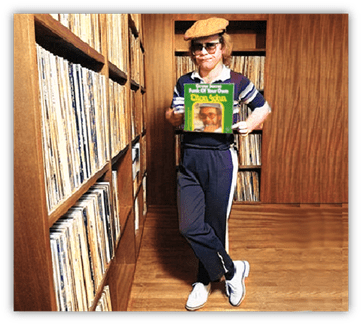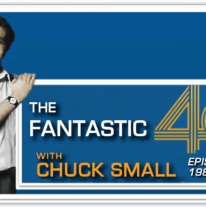He’s won Five Grammys.
Two Oscars.
A Tony.
And: he’s also helped kill what had been a music industry standard: the double-sided hit.
How it happened is fascinating but has been little noted. Let’s rectify this oversight now.
What Was a Double-Sided Hit?

Single records used to come out on vinyl with two songs, one printed on each side of the single.
Typically, the side of the record that companies promoted as being a hit to deejays and jukebox operators was known as the “A” side. The other song would be known as the “B” side or flip side.
Sometimes, both sides would get airplay for an artist. In those cases, Billboard charted the songs separately, based on sales results and reports of play time on radio stations and jukeboxes.

Elvis Presley upended this designation in 1956 with his single “Don’t Be Cruel” backed with “Hound Dog…”
…Or was it the other way around?
Anyway, demand for both was so great that in the pre-Hot 100 days, Billboard’s Best Sellers and Juke Box charts listed both titles together at Number One for weeks.

Thereafter, record companies often tried to promote their singles as double-sided hits… usually with poor results.
Often only the biggest acts like Elvis and the Beatles managed to have both sides of a single become at least top 10 hits.
But the practice persisted.
By the 1970s, Billboard listed several double-sided hits… that really weren’t.
For example, the publication claimed that the instrumental “Free Wheelin” was generating similar airplay and sales as its A side, “You Ain’t Seen Nothing Yet” by Bachman Turner Overdrive, during the latter’s run in the top 10.
Good luck finding anyone who remembers “Free Wheelin’ “as much as its A side.

Yet it was a release by Elton John that brought double-sided hits to a halt.
Here’s how:
What Did Elton Do Wrong?

Elton’s 1975 album Captain Fantastic and the Brown Dirt Cowboy became the first LP to debut at number one in Billboard. His label, MCA, asked for a quick follow-up LP. Elton obliged.
Rock of the Westies came out in late 1975 and became the second LP to debut at number one in Billboard. Its leadoff single, “Island Girl,” went to number one in just four weeks – a rise to the top that wouldn’t be matched for nearly 10 years until “We Are the World” by USA for Africa.
A follow-up was needed to keep the momentum of the album’s sales, as had been done with singles from Captain Fantastic and the Brown Dirt Cowboy. There, “Someone Saved My Life Tonight” became a strong top four single following the number one smash “Philadelphia Freedom.”

But Rock of the Westies had nothing close to the appeal of “Someone Saved My Life Tonight.”
In fact, the latter album’s leadoff single of “Island Girl” was nowhere near as good as “Philadelphia Freedom.”
(As proof: I cite the TNOCS scores of 7.2 for “Philadelphia Freedom” versus 4.8 for “Island Girl.” Tom Breihan, writer of The Numbers Ones Column for which many contributors on this site follow, was even tougher, giving an 8 to “Philadelphia Freedom: compared to a mere 3 for :Island Girl.”)
So, MCA decided they would release a single and claim that both sides deserved to be listed as hits.
This was a big mistake.
The ostensible A side, “Grow Some Funk on Your Own”, was Elton’s clumsy attempt to get soulful.

When he didn’t try so hard, like with “Bennie and the Jets,” he did fine.
But this composition, credited to Davey Johnstone along with Elton and his usual collaborator, Bernie Taupin, is forced and phony revelry.
In contrast, the other side, “I Feel Like a Bullet (in the Gun of Robert Ford),” sounds like a lugubrious dry run for Elton’s bigger and better hit later in 1976, “Sorry Seems to Be the Hardest Word.” The clumsy title didn’t help either.
Still, both had Elton’s name and the momentum of his reputation, so they couldn’t miss, right?
How the Record Flopped
GSFOYO/IFLABITGORF debuted the week of January 24, 1976, at Number 55.

It was the highest new entry on the Hot 100 that week.
It was just 6 positions shy of the debut of Island Girl, which coincidentally fell off the chart when GSFOYO/IFLABITGORF debuted.
Of course, it’s not where you start on the Hot 100 but where you finish.
In the case of GSFOYO/IFLABITGORF, it leaped onto position 31 in its second week. Its increase of 24 positions made it the big mover on the Hot 100 for January 31, 1976. Success seemed assured.
The next week, the record moved up seven notches to 22. Not bad… but not great by Elton’s standards. It then went to 17, 15 and then 14 on February 28, 1976. Ominously, it lost its star performance bullet on the Hot 100 that week, which indicated strong movement on the chart, strong sales or both.
For the week of March 6, 1976, the record slumped dramatically to number 42. It held that position the following week, then dropped to 54, then 67 and finally barely clung to 98 the week of April 3, 1976, before disappearing.
GSFOYO/IFLABITGORF ran a mere 11 weeks on the chart. It was the worst performance by an Elton John single since “Tiny Dancer” stopped at number 41 in 1972.
But “Tiny Dancer” remains a popular oldie to this day, while GSFOYO/IFLABITGORF isn’t.

And while Elton had worse performing singles later – for example, “Heartache Over the World” in 1986, which peaked at 55 and ended his incredible streak of 38 consecutive top 40 hits since 1972 – few had the consequential impact that this flop did.
The Aftermath
The relative failure of GSFOYO/IFLABITGORF can be blamed partly on the songs’ length as well as their questionable quality.

The A side ran 4 minutes and 45 seconds, while the B side ran 5 minutes and 30 seconds.
These were long songs for top 40 radio in 1976, and many radio programmers resented giving up the airtime.

In fact, the head programmer for the influential station WABC in New York City, Rick Sklar, noted in his 1985 book Rocking America how he refused to play the record despite MCA’s efforts to promote both sides.
Thereafter, the number of attempted double-sided hits dropped off dramatically on the Hot 100. The feeling of being forced to play two sides for a company desperate to have at least one become a hit – no matter how big the artist – left a sore taste in the mouths of radio executives. No double-sided hits made the top 20 thereafter. Record companies took note.
This can be shown by what happened when the Elektra label promoted “We Are the Champions” in 1977. The company did not ask Billboard to list its B side, “We Will Rock You” on the Hot 100.

But many radio stations noted how the latter segued seamlessly to “We Are the Champions” on Queen’s album News of the World, and played the two songs accordingly as a medley.
Still, only “We Will Rock You” was listed on the Hot 100 chart as the record went to number four.
The dislike of double-sided hits had become ingrained with programmers thereafter.
The decline and near disappearance of vinyl singles made the concept rather outmoded by the 1980s.
For his part, in his autobiography Me, Elton wrote:
“It was almost a relief when the second single from Rock of the Westies, “Grow Some Funk of Your Own,” wasn’t a huge hit.
For one thing, I was exhausted … And for another, I’d never really set out to have hit singles.”
Yet, Elton did of course have plenty of hit singles then and now.
But “Grow Some Funk on Your Own” and “I Feel Like a Bullet (in the Gun of Robert Ford)” were speed bumps, in a career otherwise filled with bigger and better highlights.
Let the author know you liked their article with a “heart” upvote!






Good job, Ozmoe. I remember hearing Casey Kasem specifically note in the latter part of that week’s AT40 how we wouldn’t hear Elton’s latest because it had fallen out from the top 15.
As for the songs’ quality, I agree. “Grow Some Funk” is in its own way as offensive as its predecessor, while “Bullet” just never made sense as a single. Elton was entering his chart desert.
Exactly. I can’t even remember what “Funk” sounds like, and “Bullet” is definitely an album track, especially given its length.
Nice work, Ozmoe!
Interesting stuff, especially from this side of the pond where things work differently. As this link shows there have been 38 double A-side #1s here from the mid 60s upto 2007. The majority are from the 90s and 00s despite the decline of vinyl. Over here the double a-side remained determined by the record company (or maybe the band got a say). A purely sales based chart meant there was no scope for a nominal b-side being picked up and making it into the chart on the back of radio play or for one of the double A to chart higher.
https://www.officialcharts.com/chart-news/every-double-a-side-uk-number-1-on-the-official-singles-chart__23140/
This didn’t mean that any of these got equal attention. I’d say The Beatles offerings and Spice Girls; Mama / Who Do You Think You Are are an outlier in that both got a lot of play. There were special circumstances with Queen; Bo Rhap / Days Of Our Lives and Elton: Candle In The Wind / Something About The Way You Looked Tonight. Both started out with the more well known side dominating but as their chart runs went on and on the other sides started to accrue some play, possibly as part of moving on from the mourning periods.
For the majority though it was pretty much all about one side.
Seeing the two sides of Let It Be reminded of something I heard pointed out a while ago. That was the final single released by The Beatles before the break up (we didn’t get Long & Winding Road as a single). Meaning that You Know My Name (Look Up My Number) was the last piece of music we would hear on a Beatles single. A fine legacy to bring the curtain down on a glorious career; 4 minutes of dicking about with silly voices and sound effects featuring Mal Evans on ‘spade in gravel’ . Wouldn’t have it any other way.
I remember a fondness for IFLABITGORF because I thought that was fun to say. Don’t remember much of the rest of the song, just that one line. I didn’t (and don’t) have a tremendous tolerance for “I behaved like a jerk, but you should take me back because I’m really sorry” songs.
When mom bought me my first boombox, it came with her taste in music: Elton John’s Greatest Hits and Elton John’s Greatest Hits Volume 2. What the heck is John doing in the cover art for Volume 2, I thought. Mom? Dad? Neither of them knew. It didn’t obsess me like when I didn’t know the name of a song used in the television promo for Ralph Bakshi’s American Pop. The question soon fizzled. It never left the house.
I learned what cricket was from watching Magnum P.I. And snooker.
I didn’t like “The Border Song” from Greatest Hits. And “Grow Some Funk of My Own” from Volume 2. I wasn’t surprised when they were replaced in future reissues. “Levon” was a jam. It should have charted higher.
(The song was “Night Moves”.)
This essay, Ozmoe, helps explain to me why B-side “Metal” didn’t chart. It’s almost the equal of “Cars”.
I played the heck out of “Metal” on the b-side as a kid.
Mark this under “Things I Didn’t Know But Will Never Forget”, of TIDKBWNF.
Thanks Ozmoe!!!
Great stuff, Ozmoe!
Man, that was questionable taste from EHJ with ‘IG’ and ‘GSFOYO.’ Yeesh. I’ve been a ‘IFLAB (INTGORF)’ stan for a while, though, despite the protagonist’s whininess. Some nice imagery in there.
Queen would later feel bad for us folks who couldn’t afford the full album by slapping both ‘Bicycle Race’ and ‘Fat Bottomed Girls’ onto one 45. Admittedly, some squeamish stuff, as well. The picture sleeve of the single was another thing…
Finally, ‘American Pie’ was split into both sides of the single. Does that make it a double-sided hit, or a unicorn release?
More of a unicorn to me. But I’ll allow both 😁
Excellent article – learned a bunch today!
Thank you!
Fascinating! I’ve actually always wondered how double sided singles even came unto existence in the first place, and how they faded away.
This is good stuff, ozmoe, thanks!!